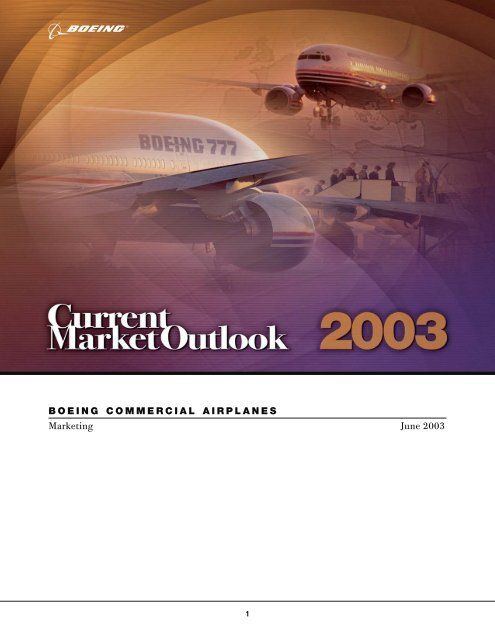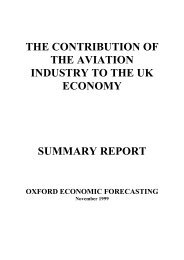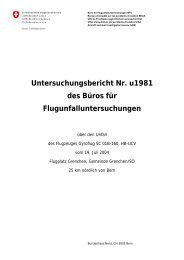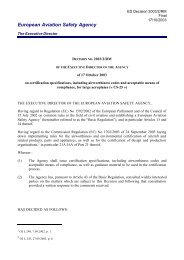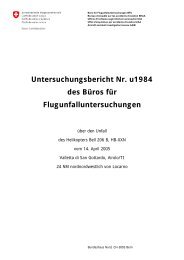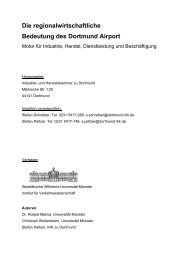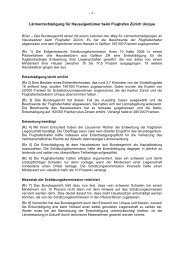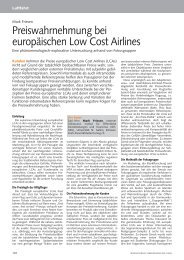BOEING COMMERCIAL AIRPLANES Marketing June 2003
BOEING COMMERCIAL AIRPLANES Marketing June 2003
BOEING COMMERCIAL AIRPLANES Marketing June 2003
You also want an ePaper? Increase the reach of your titles
YUMPU automatically turns print PDFs into web optimized ePapers that Google loves.
PURPOSEEvery year, Boeing publishes its latest assessment of the demand forworld air travel. This assessment estimates the jet airplane capacity tomeet the projected growth in travel demand, plus the replacement marketfor older in-service airplanes. This document may be referred to as theBoeing world outlook for thefuture of commercial airplanes.Boeing recently announcedplans to introduce a new, efficientintermediate-size airplane. At thetime of Current Market Outlook<strong>2003</strong> publication, the finalconfiguration of this airplaneis not yet fully defined. Althoughan explicit forecast for the newairplane is not included in thisOutlook, the underlying analysisclearly demonstrates strongmiddle-of-the-market demand. Customers continue to request frequent,nonstop service to their ultimate destinations. A new, more efficient airplanewill help airlines to profitably meet this passenger demand.The <strong>2003</strong> Current Market Outlook can also be found on the Internet at:http://www.boeing.com/commercial/cmoFor more information about the Outlook, contact:Tim Meskill, DirectorMarket AnalysisBoeing Commercial AirplanesP.O. Box 3707, MC 21-28Seattle, Washington 98124-2207 USATelephone: 206-766-2503Overview3 Current Market Outlook <strong>2003</strong>
Typically, when deregulation occurs, competition increases among airlinesto open new nonstop routes and to add frequencies, thus attracting passengersby giving them a greater choice of flights. The liberalized aviation environmentalso fosters growth of niche markets. For example, low-cost and regional jetairlines stimulate new, previously unserved demand and increase overall airtravel market size.E CONOMIC AND TRAFFIC GROWTH RATES VARY BY REGION. Traffic within Asia-Pacific will grow by almost 6% annually over the next 20 years, and the region’sshare of world RPKs will increase by almost three percentage points to over 18%.In contrast, Europe and NorthAmerica are mature economieswith lower growth rates, althoughthese regions will continue to takethe most airplane deliveries. Themarket share of flying within LatinAmerica will increase from 2% to4% of world RPKs because of a high7.3% annual traffic growth rate.T HE WORLD FLEET WILL MORETHANDOUBLE. Approximatelyone-fourth of the market for newcommercial jets can be thought of as replacement for older in-service airplanes,and the remaining three-quarters for accommodation of both passenger andcargo traffic growth.A LMOST THREE- QUARTERS OF THE FLEET WILL BE SINGLE- AISLE JETS.The share of smaller regional jets will increase from 11% to 16% of the world fleet.Airlines will use regional jets for hub feeding, taking traffic from hubs, hub bypass,point-to-point services, nonstop service on thin routes, turboprop replacement,and as a mainline jet complement, especially in off-peak hours.A IR TRAVELERS PREFER DIRECT FLIGHTS AND MORE FREQUENCIES. Passengerswill avoid itineraries that require several hub connections and numerous segmentsto complete a journey. While the share of 747 and larger airplanes will fall from7% to 4%, the percentage of intermediate-size airplanes will increase from 18% to22%. Intermediate-size airplanes allow airlines to economically fly the increasedfrequencies, city pairs, and nonstop flights requested by passengers.Overview5Current Market Outlook <strong>2003</strong>
AIR TRAVEL CYCLESCycles are a regular part of the air travel industry. However, annual negative worldtraffic growth has been experienced only twice in all of modern aviation history —in 1991 and in 2001–2002. Cycles do not change the fundamentals of economicgrowth, globalization, and the desire of people to travel. Long-term trends forair traffic growth remain healthy.The major driver of longtermair travel growth is economicgrowth. Globalization of trade isanother cause of air travel growth.The Internet further encouragestravel by opening up globalopportunities to many morepeople. Airline network serviceimprovements and declining faresexplain additional portions oftraffic expansion. DeregulationTraffic Is at a Cycle TroughWorld traffic in RPKs, billions4,0003,0002,0001,000 1985 1990 1995 2000and liberalization enhance airline competition, which in turn fosters lower faresas well as the additional frequencies and city pairs passengers desire.I N THE SHORT TERM, AIR TRAVEL IS MORE VOLATILE. Consumer confidenceand business profits can be strong influences on air travel demand during a businesscycle. Travelers treat discretionary air travel in a similar manner as they treat moredurable goods such as computers and automobiles. Visits to friends and relatives,vacations, and even business trips can be cancelled or delayed when income isdepressed or uncertain.The current short-term cycle began modestly in early 2001 with the burstingof the high-technology stock market “bubble.” After September 11, 2001, thenormal cycle turned into an extreme cycle. Fear and “hassle” factors, such as linesat security checkpoints, distorted the normal relationship between economic variablesand air travel. The recent outbreak of the SARS virus has also had a downwardeffect on the current cycle. In time, this short-term cycle will end, and the relationshipbetween traffic and economic growth will once again be paramount.Demand for Air Travel 6Current Market Outlook <strong>2003</strong>
LONG-TERM TRENDSecurity improvements impart costs on airlines and airports that arepassed on to passengers. Air travel will not recover to the pre-September 11,2001, long-term average growth trend. It will recover to a parallel trend,displaced downward by the extra cost of security. Short-haul travel will beara larger share of the burden because security costs are based on boardingsand are a larger share of total costs for shorter trips.The current forecast shows 5% fewer world RPKs at the end of20 years than there would have been without this unusual short-term cycle.Yet, air travel will continueto grow at 5.1% over the next20 years, similar to the trendfor the 20 years ending in 2000,before the current cycle.Air Travel Trends UpwardWorld traffic in RPKs, billions10,000HistoryOutlook forecastTrend if no “9/11”7,5005,0002,50020-year growth rate1981–20005.1%20-year growth rate<strong>2003</strong>–20225.1%01980 1985 1990 1995 2000 2005 2010 2015 2020Demand for Air Travel 7 Current Market Outlook <strong>2003</strong>
ECONOMIC AND TRAFFIC FORECASTWorld GDP is forecast to grow by 3.2% over the next 20 years. In matureeconomies, GDP growth will average between 2% and just over 3% per year.By contrast, GDP growth in developing regions may average over 4%.Mature economies rely on productivity gains, service industries, andconsumer markets for much of their gains, whereas emerging economiesare characterized by expanding labor forces, increased manufacturing,and entry into global capital and trade markets.China is forecast to have the fastest growing GDP at 6.2%,as it continues its successful melding of a centrally planned economywith the world market economy.GDP and RPK Growth Varies by DomicileW ORLD AIR TRAFFIC WILLAnnual growth, <strong>2003</strong>–2022WORLDCONTINUE TO GROW. World air Northeast AsiaEuropetraffic measured in RPKs willRPKOceaniaGDPgrow 5.1% annually over theNorth AmericaCISnext 20 years, approximately twoSouth Americapercentage points more than GDP.Northeast Asia, SouthAmerica, and Europe have theAfricaMiddle EastSoutheast AsiaCentral AmericaSouthwest Asialargest growth of air traffic inChinaexcess of GDP. Europe will experience0 2 4Percentage68the continuing positiveeffects of liberalization. South America will recover from present economicslowdowns and will increase air traffic through liberalization, international trade,and tourist development. Japan and Korea currently generate less air travel thantheir wealth would indicate and in the long term should show more robust airtravel rates.Southwest Asia and Africa GDP and traffic have historically lagged the world.Both regions are forecast to grow above the world average over the next 20 years,as their economies and airline industries further develop.Demand for Air Travel 8 Current Market Outlook <strong>2003</strong>
REGIONAL DIFFERENCESTwo effects determine total air travel growth for a country. The first and moresignificant effect is economic growth. The second is the value created as airlinesreduce prices and increase service offerings and as international trade grows.Over time, this second effect causes the share of GDP that a country devotesto air travel to increase. The share of GDP spent on air travel by countries withhigh initial travel shares has tended to grow more slowly than the world average.These countries have maturing air travel markets.In contrast, GDP share spent on air travel by countries with low historicaltravel shares has tended to rise faster than the world average. The RPK forecast,thus, shows considerable variation among regional flows.Because of its maturity, the North America market share of worldtraffic will decline from 24% toAir Travel Growth Differs by Region20%, as less developed marketsAdded traffic, <strong>2003</strong>–2022grow faster. For example, the2002 trafficmarket share of the combinedEurope4.5segments of the Asia-Pacificregion (China, Northeast Asia,Other Asia-PacificNorth Atlantic5.15.0and other Asia-Pacific) willEurope–Asia5.6increase from 16% to 19%.Transpacific5.3China8.4The North Atlantic marketNorth America–5.1Latin Americawill fall slightly from 11% marketEurope–5.6Latin Americashare to 10%, and the SouthLatin America7.3Atlantic (Europe–Latin America)will remain constant at 4% share.Africa–EuropeNortheast Asia5.15.7Europe will decline from a 14% toRPKs, billionsa 13% market share.Latin America, a small region with only 2% world market share, will increaseshare to 4% because of a high 7.3% traffic growth rate fueled by liberalization andincreased world trade of South America.<strong>2003</strong>–2022growthAnnualgrowth, %North America 4.10 500 1,000 1,500 2,000Demand for Air Travel 9 Current Market Outlook <strong>2003</strong>
TRAFFIC AND FLEETAirlines purchase airplanes to fly specific routes in response to trafficdemand. Route characteristics vary by region. Airlines need large numbersof single-aisle airplanes to fly the many domestic short-haul routes withinNorth America and Europe.Growth in Regional Traffic Shapes Fleet RequirementsWithin Asia-Pacific, a farflungregion that stretches from 3,000ASKs in billionsNortheast Asia to New Zealand2,500747 and largerand across to India, a mix ofTwin-aisle2,000Single-aislesingle-aisle and twin-aisleSmall regional jetsairplanes is required. In the longhaultransoceanic markets, twin-1,5001,000aisle airplanes dominate the fleet.S HORT- HAUL MARKETS DOMINATE500DEPARTURES. Worldwide, morethan 4,300 small and intermediate0 2002 2022 2002 2022 2002 2022 2002 2022 2002 2022 2002 2022regional jets will be delivered by 2022. Short-haul markets dominate the world’sdepartures, representing over 90% of the total. Domestic flying in Europe andNorth America alone will constitute almost 43% of the world’s added ASKs andwill absorb a majority of the deliveries of single-aisle airplanes.Asia–Europe Transpacific North Atlantic Europe Asia-Pacific North AmericaA SIA-PACIFIC REQUIRES MAJOR SHARE OF LARGE CAPACITY. Over 80% of theworld’s added ASKs on large airplanes will serve travel within, to, and from theAsia-Pacific region. Because of long routes and the high number of seats on theseairplanes, relatively few large airplanes are needed to provide the ASKs thatmarket characteristics require.The combined Asia-Pacific traffic flows also comprise the bulk ofintermediate twin-aisle flying, although the North Atlantic will be the largestdiscrete traffic flow for the midsize twin aisles.Demand for Commercial Airplanes10 Current Market Outlook <strong>2003</strong>
NETWORK DEVELOPMENT STRATEGIESAirlines’ network development strategies influence their airplane acquisitiondecisions. Airlines take into account government regulations, airplane capabilitiesand economics, passenger requirements, competition from other airlines,alliances, and the maturity of an airline’s existing network.Over time, network development strategies have increasingly focused onadding new nonstop services; boosting frequencies on existing routes; competingwith other carriers on their routes; and building complementary primary,secondary, alliance, domestic, and gateway hub networks.PASSENGERS WANT TO QUICKLY REACH THEIR DESTINATIONS. Passengerswill avoid itineraries that require several hub connections and numeroussegments to complete a journey.Where possible, airlines willprovide passengers point-to-pointAirlines Provide Passengers With More Frequencies and Airport Pairs1,200service on busy routes. Whenthis is not economically feasible, 900passengers will prefer carrierswho move them over a single hub 600with one-stop connecting serviceto their final destination.300These network strategiesgenerally demand that airlinesmaintain or reduce airplane size0 1980 1990 2000 2010 2020to provide frequent, nonstop service. High-fare customers in particularare sensitive to convenient departure and arrival times. The value theyperceive in more flight-time choices outweighs the cost to airlinesof offering the added flights.Nonstop markets > 3,000 statute miles Index (1980 = 100)ASKsFrequencygrowthAirport pairsAirplane size in seatsDemand for Commercial Airplanes11 Current Market Outlook <strong>2003</strong>
FLEET GROWTHThe world fleet is expected to more than double by 2022, with totalfleet size growing to 33,999 airplanes.Over the 20-year forecast period, 5,889 airplanes will be retired fromactive commercial service and will be replaced. An additional 18,387 airplaneswill be needed to fill capacity demand.N EW <strong>AIRPLANES</strong> CONTRIBUTE TO GROWTH AND REPLACEMENT. The tally ofairplanes added and removed is a straightforward exercise. Defining the numberof airplanes attributable to growth and those attributable to replacement is not.The reason is that airplanes are not replaced jet-for-jet, but rather seat-for-seat.The 5,889 airplanes removed from the system will be replacedby some airplanes of equal size,but also by both smaller andThe World Fleet Will More Than Double Over the Next 20 Yearslarger airplanes. For example,Smaller regional jetsSingle-aisle2022Twin-aislean airline might “replace” its747 and larger 20024%737-200s (107 seats) with737-800s (162 seats). Only a7%11%22%portion of each 737-800 actually18%serves as replacement; the rest58%contributes to growth.64%Based upon an estimate of theamount of capacity removed fromthe world fleet, approximatelyone-fourth of the market for new15,612airplanes33,999airplanescommercial jets can be thought of as replacement for older in-service airplanes,and the remaining three-quarters for accommodation of both passenger andcargo traffic growth.About 62% of the fleet operating today is projected to still be inoperation 20 years from now.16%Demand for Commercial Airplanes12 Current Market Outlook <strong>2003</strong>
AIRPLANE REPLACEMENTHistorically, new capacity is added as older airplanes pass through a series ofreplacement stages. The first stage is lower utilization in response to increasingmaintenance downtime or increasing operating costs.The second stage is often the sale of an airplane to another operatorwho has different utilization requirements. For example, a new owner maymodify the airplane for cargo use, or another airline may have a need for anolder airplane type to be compatible with the rest of their fleet. Governmentnoise regulations also influence airplane retirements.A IRLINES ACCELERATED RETIREMENT OF OLDER <strong>AIRPLANES</strong>. The events ofSeptember 11, 2001, introduced a distortion to the historical model. In responseto double-digit traffic declines, airlines accelerated retirements of older airplanesand parked some newer ones.Many of the newer parkedairplanes will return to commercialservice, but older airplanesare being permanently removedfrom commercial service earlierthan they would have been pre-September 11.Additions and Removals Impact the World FleetUnits40,00030,00020,00018,387 growth airplanes5,889 replacements10,00015,612retained fleet9,723retained fleet02002 2022Demand for Commercial Airplanes13 Current Market Outlook <strong>2003</strong>
DELIVERIESThe current world fleet of 11,803 single-aisle airplanes plus regional jets isexpected to grow to 25,073 airplanes by the year 2022. Airlines will use thesesmaller airplanes to offer more frequencies in domestic service and short-haulinternational flights.N EED FOR REGIONAL JETS WILL INCREASE. The regional jet share will increasesubstantially. US regional airlines are operating smaller jets on new nonstopflights. Regional jets extend the geographic reach of Major airline hubs, augmentlarger jet operations in off-peak hours, replace Major airline larger jets on thinroutes, and substitute for prop flights.European carriers also willoperate large numbers of regionaljets, especially in hub bypassand point-to-point markets.Single-Aisle Airplanes Dominate Future Deliveries<strong>2003</strong>–2022Smaller regional jetsSingle-aisleTwin-aisle11%5%Although not at the high absolutenumbers experienced in Europe747 and larger4%18%22%and North America, other regions45%such as China will expand theiruse of regional jets over the56%next 20 years.24,2761.9 trillionairplanesdelivery dollars*I NTERMEDIATE- SIZEMARKET WILL GROW THEAIRPLANE* In year 2002 dollarsFASTEST. Midsize twin-aisle airplanes are popular with airlines for severalreasons. First, some midsize types are now capable of serving long-rangeintercontinental markets that once were restricted to long-range 747s.Second, airlines can take advantage of lower operating economicsof intermediate-size airplanes to replace older 747s. Further, most growthin the world’s airlines will manifest as increased frequencies, more nonstops,and new city pairs served by small- and intermediate-size airplanes.T HE LARGE- AIRPLANE MARKET IS SMALL. The intermediate-size fleet will morethan double, augmented by 4,753 deliveries. By comparison, the world fleet of747-size and larger airplanes is projected to grow by approximately one-third overthe next 20 years, augmented by 889 passenger and freighter airplane deliveries.There will continue to be specialized applications for 747-size and largerairplanes, such as on dense routes flown by a limited number of airlines.39%Demand for Commercial Airplanes14 Current Market Outlook <strong>2003</strong>
DEMAND FOR FREIGHTER <strong>AIRPLANES</strong>The freighter fleet will double over the next 20 years from 1,752 to3,501 airplanes. Freighters as a share of the total airplane fleet will fallfrom 11% to 10% due to an increase in the size of the average freighter.Taking 1,227 retirements into account, 2,976 airplanes will be addedto the freighter fleet by 2022.Widebody freighters, currently 41% of the fleet, will supply over halfof these additions and will end the period comprising a majority of the fleet.The shift toward widebody freighters will result in a fleetwide increase inaverage freighter airplane payload.The medium widebody fleet will nearly triple over the next 20 years —the greatest change of any category. Operators prefer medium widebodiesas a replacement for retiringWidebody Freighters Dominate the Future Fleetmedium standard body freighters.M AJORITY OF FREIGHTERSmall (65 tons)ADDITIONS WILL BE MODIFIED2002<strong>AIRPLANES</strong>. By 2022, it isanticipated that freighters of all23%38%sizes will provide over half of theworld’s total air cargo capacity,18%a slight increase from today.21%Nearly three-quarters of1,752freighter fleet additions duringfreightersthe next 20 years, satisfying bothmarket growth and replacement needs, will come from modified passenger andcombi airplanes. Over half of these conversions will be widebody conversions.By 2022, 761 new production freighters will enter the fleet. Althoughnew aircraft will comprise a minority of the world freighter fleet by 2022,many airlines prefer the technical advantages, reliability, and fuel efficiencyof new aircraft.Just over 50% of new freighter deliveries will be in the large category.The value of all the new freighters totals $132 billion in current US dollars.28%28%20223,501freighters33%11%Demand for Commercial Airplanes 15 Current Market Outlook <strong>2003</strong>
DELIVERIES BY REGIONThe mix of airplane models and number of deliveries varies widely by region.On the passenger side, North America, with its large number of experiencedtravelers and its need to replace an aging fleet, will require the most airplanesover the next 20 years.Compared with otherPassenger Airplane Deliveries Vary by RegionNumber of new airplanes, <strong>2003</strong>–2022regions, a larger number of10,000North American deliveries will beregional jets. In Europe, approximately8,000three-quarters of deliveries6,000will be single-aisle airplanes andregional jets. Asia will take4,000deliveries of the most 747-and-larger airplanes.2,000The world’s airlines willadd 2,976 new and convertedfreighters by 2022. As described0 North America Europe Asia-Pacific Latin Americain the Boeing World Air Cargo Forecast, factors such as airline strategies,retirement rates, and varying growth rates of major trade flows and marketsegments will impact the sizes of new and converted freighters added toeach region.For example, large US-based Freighter Deliveries Vary by RegionNumber of new and converted airplanes, <strong>2003</strong>–2022air express systems will add many 1,500medium and large widebodyfreighters for both growth and1,200replacement purposes. Asia-900Pacific and European airlineswill add many large long-haul 600freighters, especially new andconverted 747s.300747 and largerTwin-aisleSingle-aisleSmaller regional jetsAfrica andMiddle EastLargeMedium widebodyMedium standard-bodySmall0North AmericaEurope Asia-Pacific Latin AmericaAfrica andMiddle EastDemand for Commercial Airplanes16 Current Market Outlook <strong>2003</strong>
NORTH AMERICAEconomic growth in North America is driven by increases in productivityand continuing population growth. GDP is forecast to grow at 3.2% annuallyover the next 20 years.Air travel growth for the North America Deliveries<strong>2003</strong>–20222%region’s carriers should average Smaller regional jetsSingle-aisle4.4% annually through 2022.Twin-aisle15%747 andNorth American markets are fully26%largerliberalized, and travel levels arealready above average for thecontinent’s wealth. However,57%travel growth beyond the level ofGDP growth will still be stimulated8,530 airplanesby continued efficiencies in airline$557 billion*networks and lower fares.* In year 2002 dollarsEighty-three percent ofdeliveries to North American airlines over the next 20 years are forecastto be regional jet and larger single-aisle airplanes. These airplanes willprimarily serve domestic US and Canadian markets as well as nearbyLatin American destinations.The international market will continue to fragment as more point-topointservice and additional city pairs and frequencies are added. The NorthCMO <strong>2003</strong>_4-1America fleet consisting of intermediate-size airplanes will increase from15.0% to 17.0% to serve growing overseas markets on the Atlantic andthe Pacific and to serve Latin America.North America FleetPercentage of fleet100755025020027,034airplanes202212,758airplanesNorth America ASK MixDomiciled AirlinesScheduled Nonstops, 2000North America to:North America . . . . . . . . 72%Europe . . . . . . . . . . . . . . . 12%Northeast Asia . . . . . . . . . 6%Central America . . . . . . . . 4%South America . . . . . . . . . 3%Other . . . . . . . . . . . . . . . . . 3%Regional Summaries 17 Current Market Outlook <strong>2003</strong>
LATIN AMERICAThe outlook for economic growth in Latin America is strong, based oncontinued resource development and competitive global economic policies.Annual GDP growth over the next 20 years is expected to average 4.8% inCentral America and 4.0% in South America.Annual RPK growth for the region’s carriers is forecast at 5.8% forCentral America and 7.1% for South America over the next 20 years.Tourism to Central America isalready quite a mature industry. Latin America Deliveries<strong>2003</strong>–2022South America will grow fasterSmaller regional jetsSingle-aisle9%because of its large population,Twin-aisle18%747 andvast geography, and touristlargerdevelopment around itsspectacular terrain and73%archaeological sites.Over half of the flying ofLatin American carriers is within1,971 airplanesthe region. Regional jets and$107 billion*larger single-aisle airplanes are* In year 2002 dollarsforecast to dominate futuredelivered capacity to serve local markets. More distant intra-Latin American markets as well as business and leisure travel fromNorth America and Europe will drive the demand for intermediatesizeairplanes.CMO <strong>2003</strong>_4-2Latin America FleetPercentage of fleet100755025020021,039airplanes20222,899airplanesLatin America ASK MixDomiciled AirlinesScheduled Nonstops, 2000Latin America to:Intra-South America . . . 38%Intra-Central America . . 16%C. Amer–N. Amer . . . . . . 14%S. Amer–N. Amer . . . . . . 11%S. Amer–Europe . . . . . . . 10%C. Amer–S. Amer . . . . . . . 5%C. Amer–Europe . . . . . . . 4%Latin America–Asia . . . . . 2%Regional Summaries 18 Current Market Outlook <strong>2003</strong>
EUROPEEurope is a blend of smaller developing economies and larger mature ones.Overall, the 20-year forecast for annual GDP growth is 2.5%. Air travel of theregion’s carriers is forecast to grow at 4.9%, substantially faster than GDP.European markets are still in their first decade of liberalization, whichis rapidly stimulating air traveldemand. The rise of low-cost Europe Deliveries<strong>2003</strong>–2022carriers is also generatingSmaller regional jets 3%Single-aislenew travel growth. Lower faresTwin-aisle15%747 andand point-to-point service to22%largermany secondary and select hubairports are desirable to airtravelers. Mainline hub-and-spoke60%carriers will continue to carry feedto their growing international6,194 airplanesnetworks and serve the more$481 billion*complex and major hub itineraries* In year 2002 dollarsof intra-Europe travelers.Over three-quarters of the European fleet will continueto be regional jets and other single-aisle airplanes to serve domestic,intra-Europe, and short-haul routes to Africa and the Middle East.The share of intermediate-size twin-aisle airplanes will increasefrom 16.0% to 21.0% over the next 20 years. Fragmentation onCMO <strong>2003</strong>_4-3the Atlantic and to Asia will drive this trend.Europe FleetPercentage of fleet100755025020023,881airplanes20228,582airplanesEurope ASK MixDomiciled AirlinesScheduled Nonstops, 2000Europe to:Europe . . . . . . . . . . . . . . 39%North America . . . . . . . . 26%Central America . . . . . . . . 6%South America . . . . . . . . . 4%Africa . . . . . . . . . . . . . . . . . 7%Middle East . . . . . . . . . . . . 4%Southeast Asia . . . . . . . . . 5%Northeast Asia . . . . . . . . . 4%China . . . . . . . . . . . . . . . . . 3%Southwest Asia . . . . . . . . 2%Regional Summaries 19 Current Market Outlook <strong>2003</strong>
AFRICAWith more than 50 countries, Africa presents a wide spectrum of economicdevelopment. On average, air traffic for the region’s carriers is forecast to growat 5.3% annually over the next 20 years. This traffic builds from 4.0% annualGDP growth, with South Africa comprising a quarter of the GDP base.A number of airlines areembarking on fleet modernization Africa Deliveries<strong>2003</strong>–20223%programs, and some governments Smaller regional jetsSingle-aisleare looking at privatizationTwin-aisle747 and18%options. African nations arelarger30%beginning to participate inregional and world liberalizationwith resultant increases in trade49%and air travel.Within Africa, almost twothirdsof flight frequencies serve$40 billion*570 airplanesairport pairs in Southern Africa,* In year 2002 dollarswith the remainder divided fairlyevenly between airport pairs in Northern and Central Africa. Althoughsingle-aisle airplanes will continue to dominate the African fleet, thepercentage of intermediate-size airplanes will almost double to betterserve long-haul and larger interregional markets. Traffic from SouthernAfrica to Europe uses large airplanes.CMO <strong>2003</strong>_4-4Leisure traffic is a significant component of Africa-to-Europe flows,with North Africa continuing to increase in popularity. Cultural andeconomic ties with Europe lead to substantial business and VFR (visitingfriends and relatives) traffic.Africa FleetPercentage of fleet10075502502002641airplanes20221,034airplanesAfrica ASK MixDomiciled AirlinesScheduled Nonstops, 2000Africa to:Europe . . . . . . . . . . . . . . . 47%Africa . . . . . . . . . . . . . . . . 31%Americas . . . . . . . . . . . . . . 9%Asia-Pacific . . . . . . . . . . . . 7%Middle East . . . . . . . . . . . . 6%Regional Summaries 20 Current Market Outlook <strong>2003</strong>
MIDDLE EASTGDP is expected to grow by 4.0% and traffic at 5.6% annually overthe next 20 years for the Middle East. This growth is helped by forecastsfor strong population growth and assumes oil prices remain at long-termsustainable levels.The Middle East attracts and supplies religious, leisure, cultural,and business travelers flying worldwide. Over one million air travelersparticipate in Haj each year. Dubai and Cairo are major economiccenters for the Middle Eastand Africa, and Dubai attracts Middle East Deliveries<strong>2003</strong>–20223%international shoppers andSmaller regional jetsSingle-aisle5%MICE (meetings, incentives,Twin-aisle747 andconventions, and exhibitions)largertravelers.36%The overall fleet of Middle56%East airlines is forecast to bealmost evenly divided betweensingle-aisle and twin-aisle airplanesin 2022. Short-haul flights$81 billion*786 airplaneswithin the region and to Europe* In year 2002 dollarswill support smaller airplanes.Currently some Middle East traffic is connecting flights betweenEurope and Asia, which will decline as longer-haul direct flights increase.However, long-haul flights to Asia and North America from developinghubs in the Middle East will support sizeable numbers of intermediateand 747-size and larger airplanes.CMO <strong>2003</strong>_4-5Middle East FleetPercentage of fleet10075502502002470airplanes20221,123airplanesMiddle East ASK MixDomiciled AirlinesScheduled Nonstops, 2000Middle East to:Europe . . . . . . . . . . . . . . . 29%Middle East . . . . . . . . . . . 24%Southwest Asia . . . . . . . . 15%Southeast Asia . . . . . . . . 12%North America . . . . . . . . . 10%Africa . . . . . . . . . . . . . . . . . 6%Other Asia . . . . . . . . . . . . . 4%Regional Summaries 21 Current Market Outlook <strong>2003</strong>
NORTHEAST ASIAAnnual GDP growth in Northeast Asia is forecast at 2.1% over the next20 years. Japan is a relatively mature economy with low population growth.Korea will grow at a faster rate because it is still a developing economywith an expanding manufacturing base.Although air travel involving Japan and Korea is currently below whatone would expect given their level of wealth, liberalization and globalizationare having a positive effect.Already, the domestic Japanese Northeast Asia Deliveries<strong>2003</strong>–2022market is deregulated. Still, airSmaller regional jetsSingle-aisle8%travel markets are not fullyTwin-aisle12%747 andderegulated, distribution channels larger27%are tightly held, and internationalroutes are controlled with53%bilaterals. As changes occur, theregion will experience rapidlyexpanding air travel, which is1,470 airplanesforecast to average 5.7% annually$192 billion*over the next two decades.* In year 2002 dollarsThe percentage of theNortheast Asia fleet consisting of intermediate-size airplanes willrise from 40% to 52% over the next 20 years. Routes across the Pacificand to Europe will be subject to increasing fragmentation as moreairport pairs are served with more frequencies usingintermediate-size airplanes.CMO <strong>2003</strong>_4-6Northeast Asia FleetPercentage of fleet10075502502002630airplanes20221,716airplanesNortheast Asia ASK MixDomiciled AirlinesScheduled Nonstops, 2000Northeast Asia to:Northeast Asia . . . . . . . . 37%North America . . . . . . . . 31%Europe . . . . . . . . . . . . . . . 11%Southeast Asia . . . . . . . . 10%Oceania . . . . . . . . . . . . . . 6%China . . . . . . . . . . . . . . . . . 4%Southeast Asia . . . . . . . . . 1%Regional Summaries 22 Current Market Outlook <strong>2003</strong>
SOUTHEAST ASIAThe Southeast Asia region is a mixture of countries at varying stagesof economic growth. GDP for the region is forecast to grow at 4.7% annuallyover the next 20 years, which is above the world average of 3.2%. Air travelgrowth for the region’s carriers is expected to average 5.2% per year overthe 20-year period, with 5.8% growth within the region.Airlines within the region have diverse fleet requirements. Airlinesin Indonesia and the Philippines require large numbers of single-aisleairplanes for their domesticmarkets. Singapore has a high Southeast Asia Deliveries<strong>2003</strong>–2022proportion of twin-aisle jets toSmaller regional jetsSingle-aisle9%serve its regional and intercontinentalroutes. Carriers inlargerTwin-aisle15%747 andthis region will use ultra-longrangeairplanes to serve North29%47%American cities nonstop.Intermediate-size airplanes willbe used to develop new routes1,189 airplanesand accommodate travel requirementsfrom key business centers.$159 billion** In year 2002 dollarsThe percentage of the fleetdevoted to intermediate-size airplanes will rise from 31.0% to41.0%, and the percentage of 747-and-larger airplanes will fall from22.0% to 15.0% as airlines meet passenger demand for morenonstops and frequencies.CMO <strong>2003</strong>_4-7Southeast Asia FleetPercentage of fleet10075502502002703airplanes20221,486airplanesSoutheast Asia ASK MixDomiciled AirlinesScheduled Nonstops, 2000Southeast Asia to:Southeast Asia . . . . . . . . 24%Europe . . . . . . . . . . . . . . . 21%North America . . . . . . . . . 18%Oceania . . . . . . . . . . . . . . 12%Northeast Asia . . . . . . . . . 9%China . . . . . . . . . . . . . . . . . 8%Middle East . . . . . . . . . . . . 4%Other . . . . . . . . . . . . . . . . . 4%Regional Summaries 23 Current Market Outlook <strong>2003</strong>
SOUTHWEST ASIAThe GDP outlook of 5.5% annual growth over the next 20 years assumesthat Southwest Asia will continue its current focus on privatization,globalization, infrastructure, and tourism development. Overall trafficgrowth of the region’s carriers will average 7.0% annually over the next20 years. Traffic increase within Southwest Asia will average 8.7%, one ofthe world’s highest growth rates.Travel within Southwest Southwest Asia Deliveries<strong>2003</strong>–2022Asia and internationally reflects Smaller regional jets4%Single-aislea growing middle class that travels Twin-aisle747 andfor business, leisure, and religious36%largerpurposes. Travel to the MiddleEast supports pilgrimage flights60%and foreign-worker trips. NorthAmerican tourists and VFR(visiting friends and relatives)483 airplanestraffic travel to Southwest Asia$42 billion*via Europe, the Middle East,* In year 2002 dollarsand Asia gateways.Large numbers of single-aisle jets will be used domestically,especially in India’s deregulated market. The use of intermediate-sizeairplanes will also increase over the next 20 years. Airlines choose toserve their largest markets with growing frequencies and to reopen thinmarkets that were uneconomical with large airplanes. Services to Asia,CMO <strong>2003</strong>_4-8Europe, and Australia and New Zealand will use all types ofmidsize airplanes.Southwest Asia FleetPercentage of fleet10075502502002209airplanes2022705airplanesSouthwest Asia ASK MixDomiciled AirlinesScheduled Nonstops, 2000Southwest Asia to:Southwest Asia . . . . . . . . 37%Middle East . . . . . . . . . . . 26%Europe . . . . . . . . . . . . . . . 21%Southeast Asia . . . . . . . . . 7%Europe–No. Amer . . . . . . 6%Other Asia . . . . . . . . . . . . . 3%Regional Summaries 24 Current Market Outlook <strong>2003</strong>
CHINAThe 20-year China GDP forecast of 6.2% per year is the highest in theworld and reflects the successful integration of market forces within thecentrally planned economy. China’s entry into the World Trade Organization(WTO) in 2001 is just one example of the globalization of the Chineseeconomy. Air travel for the region’s carriers is forecast to expand at7.1% annually. The domesticmarket will increase at 8.4%. China Deliveries<strong>2003</strong>–20223%Over the next 20 years,Smaller regional jetsSingle-aisleChina will be the largest marketTwin-aisle11%747 andfor commercial airplanes outside larger23%of the United States. China’sairline industry is currentlyrapidly restructuring. Airline63%consolidation, infrastructureinvestment, network and fleet2,391 airplanesrationalization, and participation$197 billion*in major alliances will all* In year 2002 dollarscontribute to make China’sair carriers increasingly competitive in the future.Almost three-quarters of airplane deliveries to Chinese airlines overthe next 20 years will be regional jets and other single-aisle airplanes.These airplanes will serve domestic and short-range international marketsfrom China’s regional gateway cities. Intermediate-sized twin-aisle airplanesCMO <strong>2003</strong>_4-9will serve most of China’s international routes in the future as airlinesprovide more frequent and point-to-point service.China FleetPercentage of fleet10075502502002698airplanes20222,857airplanesChina ASK MixDomiciled AirlinesScheduled Nonstops, 2000China to:China . . . . . . . . . . . . . . . . 53%Europe . . . . . . . . . . . . . . . 11%North America . . . . . . . . . 11%Southeast Asia . . . . . . . . . 9%Northeast Asia . . . . . . . . . 7%Oceania . . . . . . . . . . . . . . . 6%Other . . . . . . . . . . . . . . . . . 3%Regional Summaries 25 Current Market Outlook <strong>2003</strong>
OCEANIAThe 20-year GDP growth rate for Oceania is expected to average3.2% per year. While resources including agricultural land have drivenwealth in this region in the past, broader business and services growthshould characterize the future. A 20-year average traffic growth rate of3.9% for the region’s carriers reflects a relatively mature air travel market.There are major tourism markets between Oceania and North America,Northeast Asia, and Europe aswell as a strong beginning to the Oceania Deliveries<strong>2003</strong>–2022developing market with China.Smaller regional jetsSingle-aisle8%Eight percent of deliveries overTwin-aisle747 and23%the next 20 years will be 747-andlarger-sizeairplanes to supportlarger22%these long international routes.However, the share of the largest47%airplanes will fall from 15.0%to 7.0%, while the share of692 airplanesintermediate twin-aisle jets will$59 billion*remain at 22.0% of the region’s* In year 2002 dollarsfleet. This is a by-product offragmentation as more city pairs and frequencies are added by airlines.Many islands and thin routes make the flexibility and small sizeof regional jets optimal for the area. Some of the densest routes in theworld are in Australia among its few large cities. The region, thus,requires large numbers of single-aisle airplanes.CMO <strong>2003</strong>_4-10Oceania FleetPercentage of fleet10075502502002307airplanes2022839airplanesOceania ASK MixDomiciled AirlinesScheduled Nonstops, 2000Oceania to:Oceania . . . . . . . . . . . . . . 42%North America . . . . . . . . . 21%Southeast Asia . . . . . . . . 13%Northeast Asia . . . . . . . . . 9%SE Asia–Europe . . . . . . . . 8%China . . . . . . . . . . . . . . . . . 5%Other . . . . . . . . . . . . . . . . . 2%Regional Summaries 26 Current Market Outlook <strong>2003</strong>
MARKET OUTLOOK REGIONSMarket Outlook regions have been formed to best illustratemajor world traffic flows. They do not always exactly match politicalor geographic regions.North AmericaCentral AmericaSouth AmericaEuropeAfricaMiddle EastCIS RegionAsia-PacificChinaNortheast AsiaSoutheast AsiaOceaniaSouthwest AsiaAppendices27 Current Market Outlook <strong>2003</strong>
WORLD TRAFFIC BY REGIONAL FLOW, 1985–1998APPENDIX A1RPKs in billions 1985 1990 1995 1996 1997 1998Africa–Africa 13.540 14.689 14.775 15.335 16.578 17.340Africa–Europe 43.037 47.732 57.178 66.897 75.259 79.248Africa–Middle East 5.156 7.394 6.479 6.973 7.490 8.187Africa–North America 1.220 1.298 2.640 3.126 4.599 4.201Central America–Central America 12.820 14.306 18.267 17.858 18.409 19.440Central America–Europe 17.868 27.647 44.193 47.507 51.720 56.737Central America–North America 43.339 63.714 71.097 74.580 76.539 80.835Central America–South America 3.287 3.499 4.271 4.595 5.269 6.608China–China 8.436 18.254 56.624 61.156 61.679 62.468China–Europe 9.577 16.927 26.611 29.352 32.407 34.157China–North America 7.807 13.434 21.630 24.143 27.094 29.670China–Northeast Asia 6.754 10.916 15.998 17.343 18.037 16.738China–Oceania 3.002 5.810 9.234 10.674 11.102 11.435China–Southeast Asia 8.081 14.489 23.032 27.200 28.532 26.764CIS Region–CIS Region 175.814 224.240 63.395 50.764 44.489 38.704CIS Region–International 15.863 24.098 33.918 39.483 42.595 44.511Europe–Europe 170.048 258.346 306.836 324.374 347.578 379.055Europe–Middle East 43.436 41.512 44.920 47.897 51.861 54.869Europe–North America 158.599 230.688 278.895 296.434 324.061 351.578Europe–Northeast Asia 17.025 29.347 46.550 54.561 58.381 59.665Europe–South America 12.250 22.309 32.930 37.211 40.262 46.260Europe–Southeast Asia 26.600 46.386 65.884 72.032 81.483 82.868Europe–Southwest Asia 11.859 17.470 20.666 23.353 22.697 24.354Middle East–Middle East 17.685 19.462 20.713 21.789 22.373 23.871Middle East–North America 5.012 6.560 10.309 11.258 10.581 12.454Middle East–Southeast Asia 15.136 10.980 20.584 20.442 20.832 20.061Middle East–Southwest Asia 14.505 16.583 23.194 23.762 24.261 25.934North America–North America 470.633 589.055 670.470 721.958 758.000 781.491North America–Northeast Asia 46.880 95.162 121.512 129.111 139.994 129.993North America–Oceania 11.008 18.972 24.135 24.820 24.996 25.067North America–South America 14.460 19.615 35.885 38.339 43.015 46.217North America–Southeast Asia 8.013 15.324 25.886 25.981 30.705 28.540Northeast Asia–Northeast Asia 32.273 50.016 67.404 71.708 75.382 74.353Northeast Asia–Oceania 6.055 12.879 31.823 35.322 36.383 25.322Northeast Asia–Southeast Asia 15.998 32.512 44.335 47.832 50.703 45.734Oceania–Oceania 18.614 26.241 42.671 44.547 45.808 46.511Oceania–Southeast Asia 12.233 24.286 33.065 36.769 38.936 36.989South America–South America 29.477 33.841 39.670 42.248 46.600 51.959Southeast Asia–Southeast Asia 17.665 29.881 53.811 58.223 61.136 48.909Southeast Asia–Southwest Asia 5.658 5.804 8.104 8.873 9.540 9.588Southwest Asia–Southwest Asia 10.471 11.602 15.205 16.117 16.130 15.775Rest of the World 5.963 8.221 12.416 15.804 16.205 15.746World total 1573.158 2181.501 2567.213 2747.755 2919.698 3000.208Appendices28 Current Market Outlook <strong>2003</strong>
WORLD TRAFFIC BY REGIONAL FLOW, 1999–2022APPENDIX A2<strong>2003</strong>–2022RPKs in billions 1999 2000 2001 2002 2012 2022 %/yearAfrica–Africa 18.034 19.422 19.947 21.203 38.234 59.021 5.3Africa–Europe 88.362 99.407 96.226 97.188 173.365 265.020 5.1Africa–Middle East 8.760 9.811 10.596 13.192 23.973 37.029 5.3Africa–North America 4.407 4.416 4.615 4.292 9.963 15.125 6.5Central America–Central America 21.384 23.950 23.016 23.382 53.499 95.970 7.3Central America–Europe 61.162 66.361 72.997 69.712 114.070 176.487 4.8Central America–North America 86.493 93.931 93.462 95.798 148.402 230.206 4.5Central America–South America 6.046 7.256 7.169 7.097 14.067 24.391 6.4China–China 64.030 73.634 80.629 87.966 219.100 444.865 8.4China–Europe 37.470 40.093 40.173 42.583 75.608 121.781 5.4China–North America 30.857 33.171 36.179 33.212 55.832 87.945 5.0China–Northeast Asia 17.508 19.434 18.423 24.503 43.772 74.219 5.7China–Oceania 11.263 12.130 12.434 13.180 20.056 29.059 4.0China–Southeast Asia 27.208 29.330 31.677 36.903 56.728 90.473 4.6CIS Region–CIS Region 39.363 41.725 46.732 51.873 82.797 126.575 4.6CIS Region–International 42.063 43.325 43.542 42.671 93.948 150.252 6.5Europe–Europe 409.063 440.104 449.306 453.799 731.215 1099.446 4.5Europe–Middle East 59.643 65.011 55.324 54.218 112.896 171.450 5.9Europe–North America 380.055 419.961 377.545 349.229 624.487 918.570 5.0Europe–Northeast Asia 60.559 63.587 55.829 53.317 114.365 181.547 6.3Europe–South America 51.118 53.162 52.098 47.930 104.274 172.953 6.6Europe–Southeast Asia 89.912 95.756 95.948 96.428 162.388 249.219 4.9Europe–Southwest Asia 24.719 26.227 27.486 27.568 56.665 95.550 6.4Middle East–Middle East 25.303 27.834 27.138 27.545 47.047 73.614 5.0Middle East–North America 14.333 16.053 12.040 10.354 23.565 35.808 6.4Middle East–Southeast Asia 21.586 23.960 22.858 24.001 44.772 69.375 5.5Middle East–Southwest Asia 27.490 29.414 29.855 31.050 57.761 96.635 5.8North America–North America 823.969 866.929 807.978 791.010 1192.016 1750.075 4.1North America–Northeast Asia 137.402 140.150 127.536 121.159 231.560 364.310 5.7North America–Oceania 26.861 29.950 27.554 26.452 38.906 58.736 4.1North America–South America 45.431 47.248 44.791 42.686 85.978 143.957 6.3North America–Southeast Asia 31.422 32.050 29.326 30.499 55.091 84.603 5.2Northeast Asia–Northeast Asia 77.104 79.032 80.217 85.031 154.907 258.950 5.7Northeast Asia–Oceania 22.284 24.066 22.502 24.505 41.431 63.489 4.9Northeast Asia–Southeast Asia 46.649 48.515 47.787 54.430 91.469 151.486 5.3Oceania–Oceania 47.441 49.244 50.721 50.214 66.903 90.694 3.0Oceania–Southeast Asia 41.613 46.190 47.576 46.625 72.117 108.047 4.3South America–South America 52.218 53.523 50.793 52.673 121.626 222.769 7.5Southeast Asia–Southeast Asia 50.376 53.650 57.030 60.566 109.563 185.356 5.8Southeast Asia–Southwest Asia 10.355 10.935 11.591 12.576 23.746 41.916 6.2Southwest Asia–Southwest Asia 15.696 16.010 16.618 17.416 45.307 91.615 8.7Rest of the World 15.990 18.413 20.061 21.145 42.201 66.792 5.9World total 3173.003 3394.373 3285.325 3277.181 5675.670 8875.379 5.1Appendices29 Current Market Outlook <strong>2003</strong>
PASSENGER AND FREIGHTER FLEET DEVELOPMENTAPPENDIX B1Year-end <strong>2003</strong>–2022 Removed Year-endSeat category* 2002 new deliveries from service 2022Single-aisleSmall and intermediate regional jets 1,752 4,303 585 5,47090–170 7,900 11,249 4,084 15,065171–240 1,132 2,307 425 3,014Twin-aisleSmall 1,489 2,521 887 3,123Intermediate 839 2,482 292 3,029Large 748 653 604 797Total passenger airplanes 13,860 23,515 6,877 30,498Year-end <strong>2003</strong>–2022 Removed Converted to Year-end2002 new deliveries from service freighter 2022FreighterSmall 659 58 551 991 1,157Medium 684 305 430 793 1,352Large 409 398 246 431 992Total freighter airplanes 1,752 761 1,227 2,215 3,501Total 15,612 24,276 8,104 33,999*Categories based on 36-/32-inch mixed-class configuration (includes freighter and combi airplanes in appropriate passengercategory; the twin-aisle and large categories also show typical three-class configurations).Appendices30 Current Market Outlook <strong>2003</strong>
WORLD AIRLINE FLEET DISTRIBUTIONAPPENDIX B22002 year-end 2022 year-endSeat category* Models Units Percent Units PercentSingle-aisleSmall and intermediate F 28 1,765 11.3 5,470 16.1regional jets F 70Bac 1-11RJ70/RJ85; BAe 146-100/-200Other regional jets90–170 717-200 8,546 54.7 16,194 47.6727737-100 through 737-800A318/A319/A320DC-8-10/-20DC-9MD-80F 100RJ100/BAe 146-300CaravelleConcordeTrident-3, MercureLarger regional jets171–240 737-900 1,492 9.6 3,409 10.0757707-300B/CA321DC-8-30/-40/-50/-60/-70Twin-aisle230–310 767 1,813 11.6 4,108 12.1(181–249) A300A310A330-200DC-10L-1011311–399 777 987 6.3 3,445 10.1(250–368) A330-300A340MD-11Large747 and larger 747 1,009 6.5 1,373 4.1(>400) A380Total 15,612 100.0 33,999 100.0* Categories based on 36-/32-inch mixed-class configuration (includes freighter and combi airplanes in appropriate passengercategory; the twin-aisle and large categories also show typical three-class configurations).Appendices31 Current Market Outlook <strong>2003</strong>
DELIVERY DISTRIBUTION, HISTORY 1952–2002APPENDIX B32002 dollarsSeat category* Models (billions) Percent Units PercentSingle-aisleSmall and intermediate F 28 54.9 4.2 2,301 10.8regional jets F 70Bac 1-11RJ70/RJ85; BAe 146-100/-200Other regional jets90–170 717-200 474.9 35.9 11,665 54.9727737-100 through 737-800A318/A319/A320DC-8-10/-20DC-9MD-80F 100RJ100/BAe 146-300CaravelleConcordeTrident-3, MercureLarger regional jets171–240 737-900 160.8 12.2 2,511 11.8757707-300B/CA321DC-8-30/-40/-50/-60Twin-aisle230–310 767 266.6 20.2 2,490 11.7(181–249) A300A310A330-200DC-10L-1011311–399 777 149.1 11.3 972 4.6(250–368) A330-300A340MD-11Large747 and larger 747 214.7 16.2 1,319 6.2(>400)Total 1,321.0 100.0 21,258 100.0* Categories based on 36-/32-inch mixed-class configuration (includes freighter and combi airplanes in appropriate passengercategory; the twin-aisle and large categories also show typical three-class configurations).Appendices32 Current Market Outlook <strong>2003</strong>
DELIVERY DISTRIBUTION, FUTURE <strong>2003</strong>–2022APPENDIX B42002 dollarsSeat category* Models (billions) Percent Units PercentSingle-aisleSmall and intermediate Fewer-than-90-seats 96.5 5.0 4,303 17.7regional jetsregional jets90–170 717-200 575.5 30.0 11,307 46.6737-600/-700/-800A318/A319/A320Larger regional jets171–240 737-900 170.0 8.9 2,340 9.6757A321Twin-aisle230–310 767 370.7 19.4 2,793 11.5(181–249) A300A310A330-<strong>2003</strong>11–399 777 488.3 25.5 2,644 10.9(250–368) A330-300A340Large747 and larger 747-400 214.0 11.2 889 3.7(>400) A380Total 1,915.0 100.0 24,276 100.0* Categories based on 36-/32-inch mixed-class configuration (includes freighter and combi airplanes in appropriate passengercategory; the twin-aisle and large categories also show typical three-class configurations).Appendices33 Current Market Outlook <strong>2003</strong>
RESULTS BY REGION OF THE WORLDAPPENDIX CAfrica Asia-Pacific Europe<strong>2003</strong>–2022 <strong>2003</strong>–2022 <strong>2003</strong>–2022Traffic Growthto/from: %/year %/year %/yearAfrica 5.3 4.8 5.1Asia 4.8 5.9 5.6Europe 5.1 5.6 4.5Middle East 5.3 5.7 5.9Latin America 7.4 5.7 5.6North America 6.5 5.3 5.0Airplane DeliveriesNumber of airplanesSingle-aisle and regional jets 452 3,507 4,632Twin-aisle 103 2,238 1,358747 and larger 15 480 204Total 570 6,225 6,194Delivery dollars, billions (2002)Single-aisle and regional jets 19.7 170.3 225.6Twin-aisle 16.6 361.9 207.8747 and larger 3.3 116.8 47.3Total 39.6 649.0 480.7Middle East Latin America North America<strong>2003</strong>–2022 <strong>2003</strong>–2022 <strong>2003</strong>–2022Traffic Growthto/from: %/year %/year %/yearAfrica 5.3 7.4 6.5Asia 5.7 5.7 5.3Europe 5.9 5.6 5.0Middle East 5.0 6.4Latin America 7.3 5.1North America 6.4 5.1 4.1Airplane DeliveriesNumber of airplanesSingle-aisle and regional jets 459 1,790 7,110Twin-aisle 284 181 1,273747 and larger 43 0 147Total 786 1,971 8,530Delivery dollars, billions (2002)Single-aisle and regional jets 25.0 78.1 323.3Twin-aisle 45.5 29.2 197.9747 and larger 10.3 0.0 36.2Total 80.8 107.3 557.4Appendices34 Current Market Outlook <strong>2003</strong>
RESULTS BY ECONOMY, <strong>2003</strong>–2022APPENDIX DInvestment*Category 2002 dollars, billions Airplane deliveries*United States 512 7,846China 197 2,391Japan 137 1,040United Kingdom 109 1,238Germany 86 991France 59 634Australia, Brazil, Canada, Singapore, South Korea 40–55 250–750Italy, Mexico, Netherlands, Spain, Taiwan, Thailand 25–40 200–550India, Ireland, Malaysia, Saudi Arabia, South Africa, 15–25 120–370United Arab EmiratesArgentina, Indonesia, New Zealand, Pakistan, Switzerland, Turkey 10–15 100–250Austria, Belgium, Chile, Egypt, Finland, Greece, Iran, Israel, 5–10 60–150Kuwait, Philippines, Poland, Portugal, SwedenAlgeria, Bahrain, Bangladesh, Colombia, Cyprus, Czech Republic, 1–5 10–90Denmark, El Salvador, Hungary, Iceland, Jamaica, Jordan, Kenya,Luxembourg, Morocco, Nigeria, Norway, Oman, Peru, Qatar,Romania, Sri Lanka, Tunisia, Venezuela, Vietnam* Totals shown are per economy in each category.Appendices35 Current Market Outlook <strong>2003</strong>
ABOUT THE DATAThe sources used in the preparation of theBoeing Current Market Outlook include:AirclaimsAir Transport Association (ATA)Association of Asia Pacific Airlines (AAPA)Association of European Airlines (AEA)Boeing primary researchGlobal InsightInternational Air Transport Association (IATA)International Civil Aviation Organization (ICAO)Jet Information ServicesOfficial Airline Guide (OAG)ROM AssociatesUS Department of Transportation Form 41Historical data are estimates based on Boeing analyses.Data for 2002 are preliminary.Appendices 36 Current Market Outlook <strong>2003</strong>
GLOSSARYASK: Available seat-kilometers — the number of seats an airlineprovides multiplied by the number of kilometers they are flown;a measure of airline capacity.CIS: Commonwealth of Independent States — states of the formerSoviet Union.GDP: Gross domestic product — the total output of goods and servicesproduced within a country; the broadest measure of economic outputwith the exception of GNP (gross national product), which includesa country’s nationals who work in other countries.L OAD FACTOR: Revenue passenger-kilometers divided by availableseat-kilometers.RPK: Revenue passenger-kilometers — the number of passengers multipliedby the number of kilometers they fly.T RAVEL SHARE: A ratio measuring the portion of GDP that a countrydevotes to air travel.Y IELD: Revenues divided by revenue passenger-kilometers; it representsan aggregate of all the airfare and airline charges and is measuredon a per-kilometer basis.Appendices 37 Current Market Outlook <strong>2003</strong>


